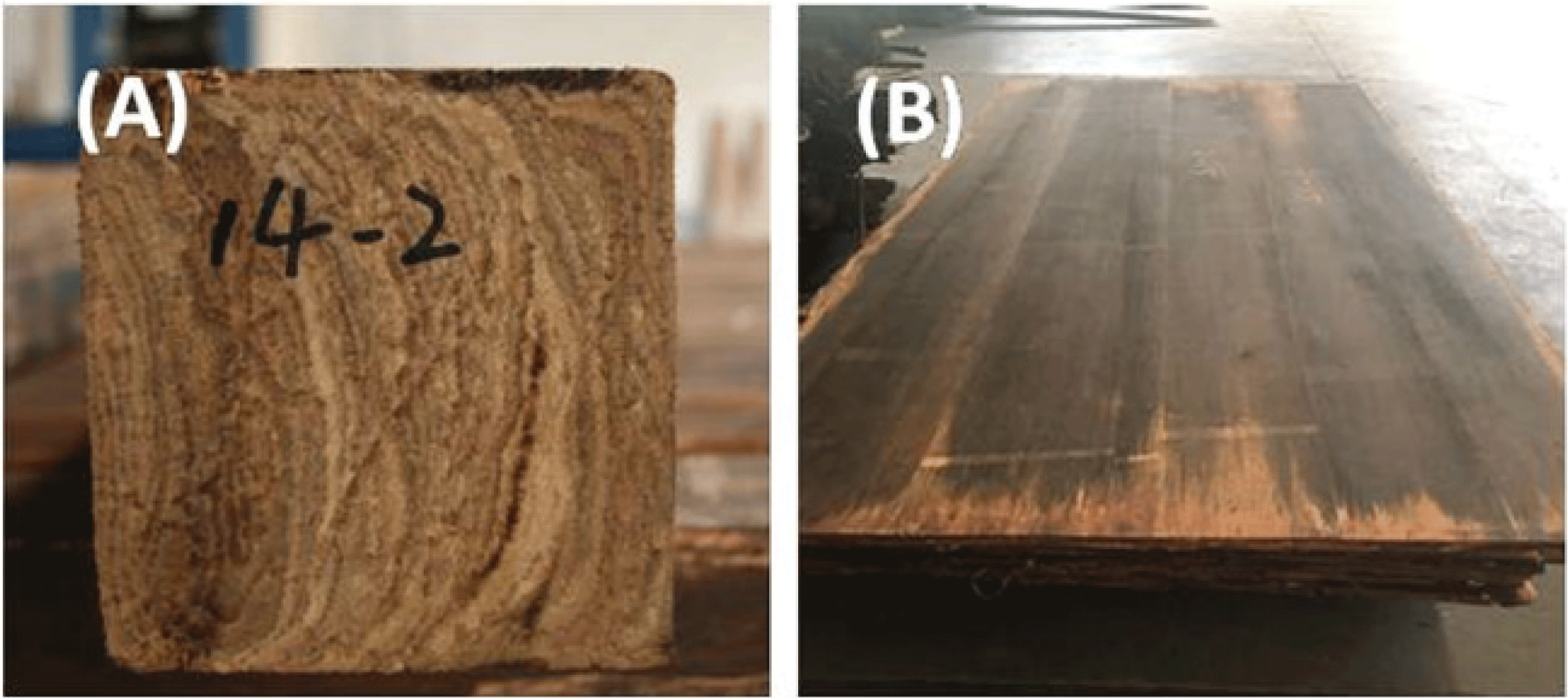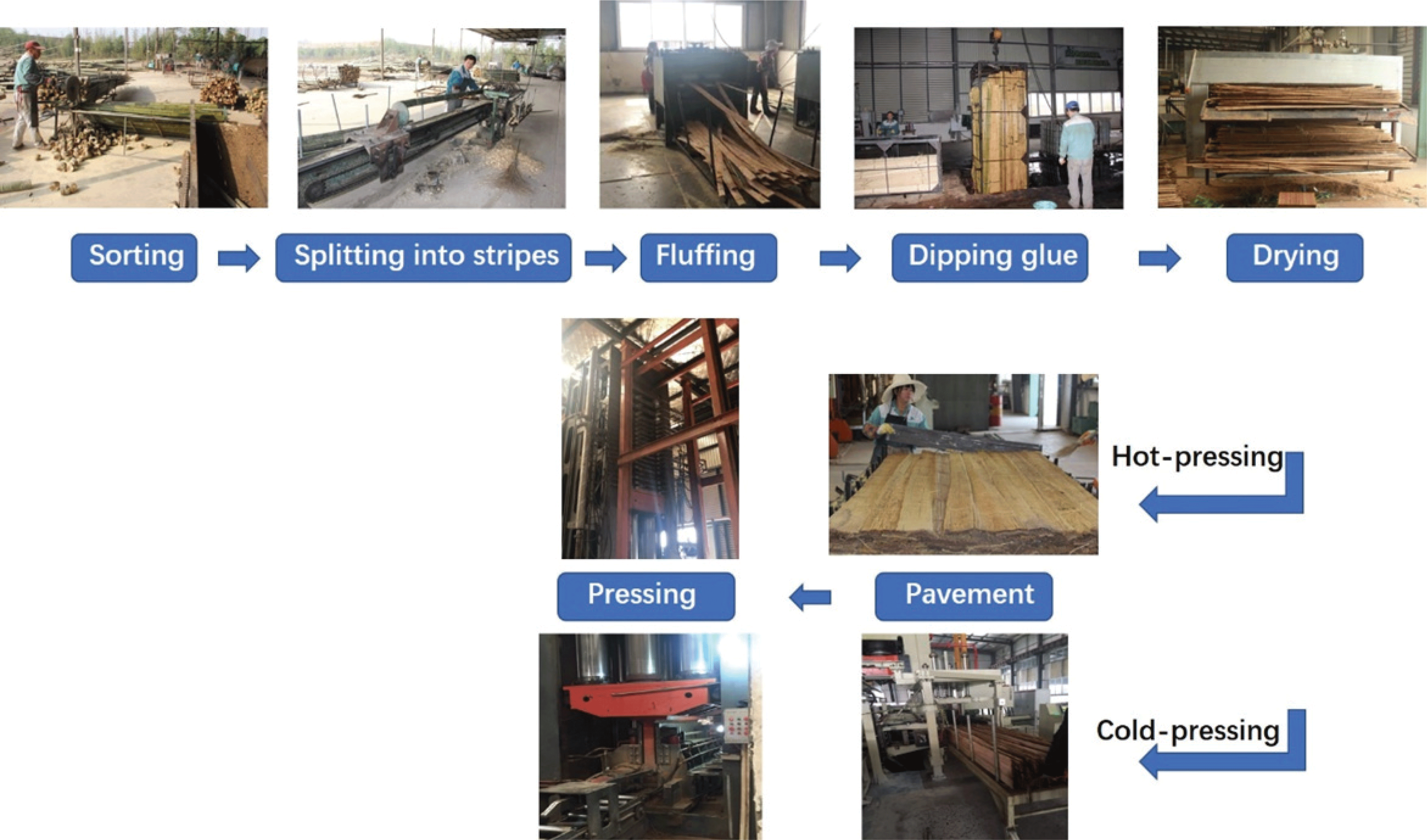1. INTRODUCTION
Bamboo has fast growth rotation owing to its light weight and high tensile strength in comparison with other species of wood (Roh et al., 2004; Roh, 2007). Bamboo is widely utilized for the industry, construction, furniture, household equipment, and handicrafts (Maulana et al., 2017). Bamboo composites, such as plywood and strand board, have attracted a significant amount of attention of the researchers (Lee et al., 1996; Lee et al., 2000). So far, bamboo has been used in several industrial manufacturing processes. Thus, bamboo-based composites are important for improving both the quality of manufacturing and production and also in research and development (John and Thomas, 2008; John et al., 2008).
However, considering the advantages of bamboo and its productivity, one of the most promising usages is to manufacture the composite by crushing and fluffing bamboo mat and recombining them. In previous researches (Yu et al., 2015; Zhang et al., 2016), bamboo composites were manufactured with high strength, large scale, and natural texture. Thus, the bamboo composite could be used in the field of engineering and decoration.
Currently, hot- and cold-pressing are two bamboo composite manufacturing techniques. These techniques differ with respect to the curing method and product dimension (Fig. 1). However, the bamboo composites manufactured by both the pressing ways can be applied in construction, flooring, and decoration. Thus, in this study, for evaluating the influence of pressing method and density on bamboo fiber-based composites (BFBCs), the mechanical properties and dimensional stabilities were determined and compared.
2. MATERIALS and METHODS
The bamboo species, namely Phyllostachys heterocycla (P. heterocycla), were obtained from south China. Liquid phenolic formaldehyde (PF) adhesive (Dynea Chemical Industry Co., Ltd., Guangdong, China) was used for composite manufacturing with a solid content of 44.2%.
The bamboo culms with the moisture contents of 8%-10% were split into several strips and were then produced into oriented bamboo fiber mat (OBFM) via a fluffing machine (Guosen, Qingdao, China). The dimensions of the average length, width, and thickness were 2,000, 100-200, and 2-5 mm, respectively.
The obtained OBFMs were carbonized for 2 h and were totally impregnated in PF adhesive with a 12% solid content for 10 min. The moisture content in impregnated OBFMS was controlled at approximately 8%-10% via oven drying for 12 h. Then, the prepared materials were hot-pressed at 145°C at a rate of 1.0 mm/min. For cold pressing, the glued OBFMs were laid and pressed in a chamber (Fig. 2) and then were transmitted on the curing device for 14 h at 135 °C. The curing duration of manufacturing was 14 h. After completing the above processes, the obtained BFBCs were placed at ambient temperature for cooling. The BFBC density was determined by measuring its air-dry weight and volume after the composites were kept in a conditioning room with a relative humidity of 65 ± 3% at 25 °C ± 2 °C for 2 weeks. After measurement, the samples with exact densities of 1.0, 1.1, and 1.2 kg/m3 were selected for evaluating properties.
Mechanical properties were tested using a universal testing machine (WDW-W10, Time Co., Ltd., Jinan, China). The samples with dimensions of 450 mm (length) × 24 mm (width) × 20 mm (thickness) were used to measure the modulus of rupture (MOR) and modulus of elasticity (MOE) according to GB/T 17657 (2013). Compressive strength and shear strength (perpendicular to loading) were measured with the dimensions of 120 mm (length) × 40 mm (width) × 20 mm (thickness) and 80 mm (length) × 20 mm (width) × 20 mm (thickness) in accordance with ASTM D 3501 (2005) and GB/T 20241 (2006), respectively.
For the evaluation of dimensional stability, the thickness swelling ratio (TSR), width swelling ratio (WSR), and water absorption ratio (WAR) were evaluated and calculated using the following equations:
where T1 and T2 represent the thickness of the specimens before and after water immersion treatment, respectively.
where W1 and W2 represent the width of the specimens before and after water immersion treatment, respectively.
where WA1 and WA2 represent the weight of the specimens before and after water immersion test, respectively.
The entire measurements were followed by immersion in boiling water for 4 h, oven drying at 63°C for 20 h, and finally re-immersion in boiling water for 4 h according to Chinese national standards GB/T 30364 and GB/T 20241. All the measurements were repeated for at least five times.
3. RESULTS and DISCUSSION
The data on the dimensional change of BFBCs are presented in Table 1. The swelling of all samples increased with an increase in the water immersion time from 4 h to 28 h due to the decrease of internal stress and the interfacial failure between the resin and OBFMs. For 4 h immersion, the WSR of BFBCs decreased with an increase in the density from 1.0 to 1.2 kg/m3. In comparison with the WSR, TSR of all the specimens pressed with two ways showed significant variation. With an increase in the density, the TSR value of hot-pressed specimens decreased from 4.03% to 2.5%; whereas, for cold-pressed specimens, it decreased from 2.95% to 1.48%. For 28 h immersion, the WSR of hot-pressed specimens decreased from 0.79% to 0.49%, and that of cold-pressed specimens decreased from 2.54% to 1.78%. Moreover, a similar trend in the density variation was observed for the WSR and TSR value in 28 h water immersion. Notably, the swelling ratio decreased with the increasing density of BFBCs, which can be attributed to the reduction in the internal void volume. As a result, the water penetration into the layer or cell wall is obstructed.
WA percentages for both the manufacturing methods are shown in Table 1. With an increase in the water immersion time, WA also increased during hot- and cold-pressing processes, which can be attributed to an increase in the broken ratio of the adhesive layer. Moreover, WA of the specimens with a density of 1.20 kg/m3 is lowest due to the crushed abundant parenchyma cells and the cells were penetrated and covered by the resin, thus hindering water penetration (Chung and Wang, 2018). Consequently, the high-density BFBC with low porosity has a positive influence on WA reduction. The WA reduction could be attributed to the decreased porosity in the BFBCs. Meanwhile, the WSR and WA values of hot-pressed specimens are significantly lower than those for cold-pressed specimens, whereas high TSR values were observed in the hot-pressed specimens at 4 and 28 h water immersion. The difference between two pressing ways might be related to the different pressing durations, temperature or even pavement direction. Overall, regardless of the pressing method used, the results in the measurement of dimensional stability have been up to the standard of GB/T 30364 (2013) and GB/T 20241 (2006). Upon comparing both the pressing methods, detailed information is provided for the manufacturing factory. Thus, an optimal way can be selected according to the requirement of products or industrial conditions.
The mechanical properties of the experimental materials are displayed in Table 2. The compressive strength of specimens significantly improved with an increase in density for both two pressing methods. The compressive strengths of hot-pressed specimens are 116.12, 137.10, and 147.62 MPa, and that for the cold-pressed specimens are 110.9, 122.06, and 125.22 MPa. These results could be related to an increase in the fiber amount or compression ratio with an increase in the density. With BFBCs of the same thickness, the addition of fiber amount could lead to a high compression ratio. Moreover, as the compression ratio increased, the bonding point would be increased to join the adhesive with bamboo fiber. Thus, the density has a significant influence on the compressive strength. With respect to the shear strength, a slight increase is observed in the hot-pressed specimens with an increase in the density, and the shear strength of specimens in cold-pressed condition has almost the same values. Zhu et al. (2015) examined that the shear strength of P. heterocycla BFBCs was 17.98 MPa with a density of 1.15 kg/m3. However, for the cold-pressed BFBCs, no significant influence of density was observed on shear strength. The results revealed that the hot-pressed BFBCs had a significantly higher value of MOR and MOE than cold-pressed specimens (Table 2). The MOR and MOE values in hot-pressed specimens showed a similar trend as in the cold-pressed specimens, which slightly increased with an increase in the density, according to the ANOVA test. The MOR values ranged from 180.37 to 187.00 MPa in hot pressing and from 162.33 to 175.96 MPa in cold pressing. Moreover, the MOE values in hot pressing ranged from 17,047.33 to 17,915.00 MPa with a density ranging from 1.0 to 1.2 kg/m3, whereas it was 16,487.5 to 17,675.33 MPa in cold-pressed specimens. The previous studies noted that the PF resin acts as a low molecular weight prepolymer and determines the degree of polymerization during curing (Rowell, 1991; Zhu and Yu, 2011).
4. CONCLUSION
This study investigated and compared the properties of BFBCs. The dimensional stability improved with an increase in the density. Moreover, at the same density level, the value of WSR, TSR, and WAR was low in hot-pressed BFBCs, whereas compressive strength, MOR and MOE perfromed higher values in the specimens for hot pressing method. However, a significant difference was observed between different pressing processes. In addition, for the selection of the pressing method, the demands of products and factory condition should also be considered. Therefore, the data in this study provided the detailed information for the industrial manufacturing.


